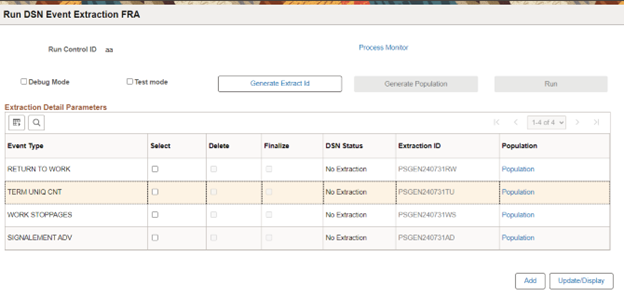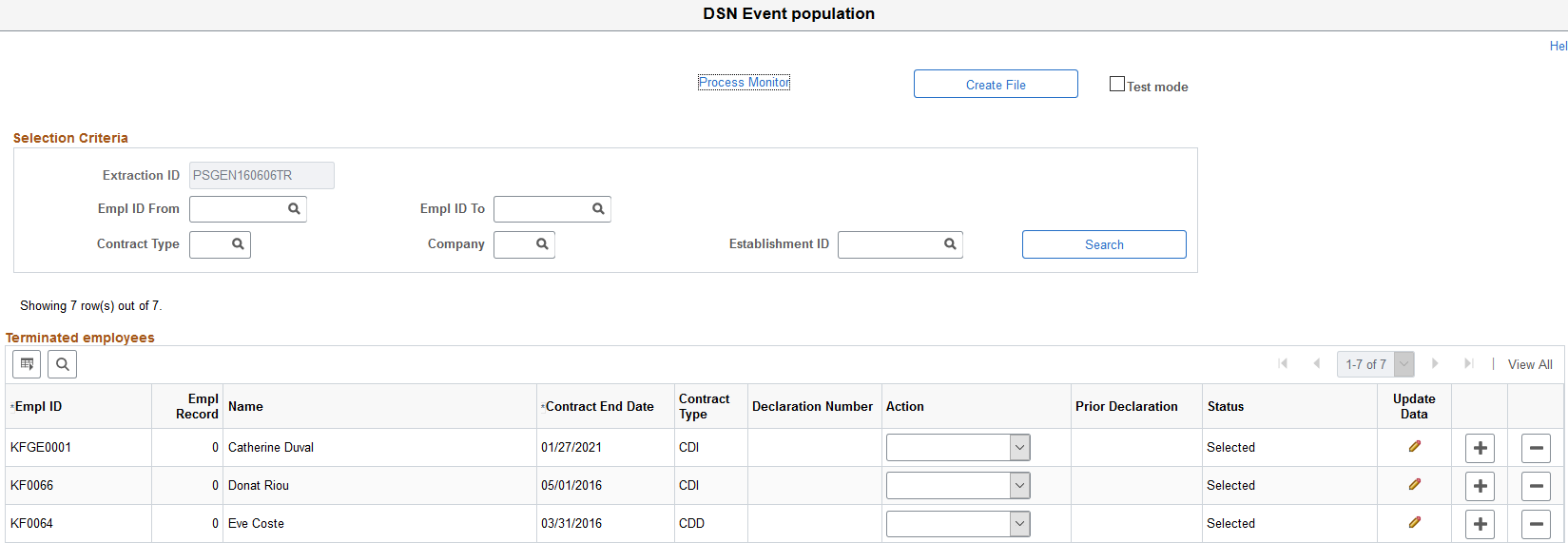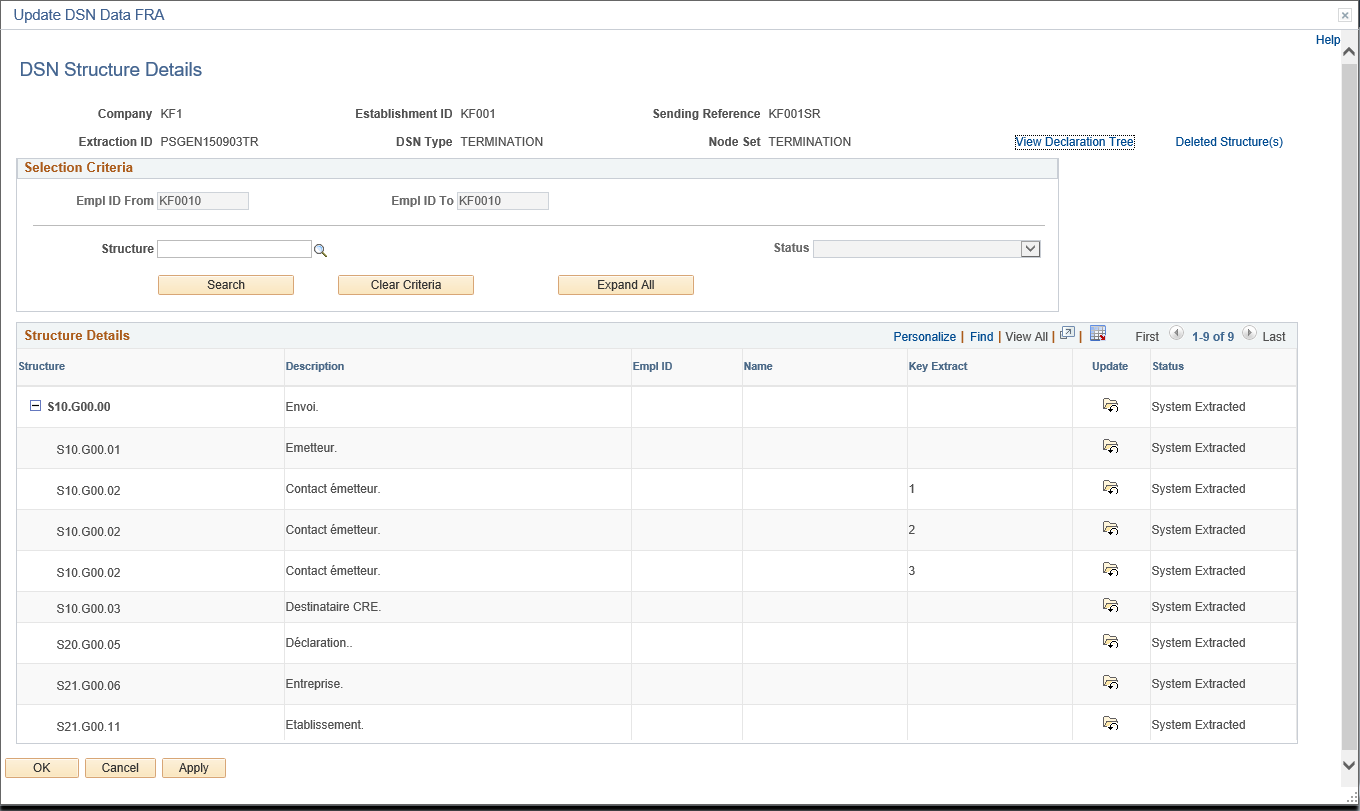Extracting DSN Data - Event Based
This topic discusses the pages used to run the DSN Event reporting process.
DSN Event reporting process is used to communicate:
A work stoppage in the event of illness, maternity, paternity, work accident.
An early return to work if the employee resumes his activity within the establishment before the end date reported on the stoppage communication.
End of employment contract for any departure of an employee from the company (resignation, etc.).
Other changes affecting employee’s right or PAS calculation.
|
Page Name |
Definition Name |
Usage |
|---|---|---|
|
GPFR_DSN_EVT_RUN |
Used to run the DSN event extraction process. |
|
|
GPFR_DSN_EVT_EE |
Used to manage the employee population for DSN Event reporting without accessing the component Run DSN Event FRA which the user could not have access to. |
Use the Run DSN Event Extraction FRA page (GPFR_DSN_EVT_RUN) to run the DSN event process.
Navigation:
This example illustrates the fields and controls on the Run DSN Event Extraction FRA page. You can find definitions for the fields and controls later on this page.

Note: The event types that are listed in this component are the ones that are setup with Frequency Equal Event, in the Application/Node set component: Menu > Set Up HCM >Product Related > Global Payroll & Absence Mgmt > Social Security /Insurance > Application/Node Set FRA, Node Set Definition.
|
Field or Control |
Description |
|---|---|
|
Generate Extract Id |
Click this button to create an Extraction ID that includes parameters like range of dates, DSN version, etc. Extraction ID is created following this logic: PSGEN+YYMMDD+CODE Where CODE is filled with: WS: for Work stoppages events RT: for Return to work events TU: for termination of unique contracts AD: for Signalement ADV events |
|
Generate Population |
Click this button to run the DSN application framework for the nodes involved in the selection of employees/events. The process fills the below records:
To run this process, system creates an additional Extraction ID, with the same naming convention than the general one, but starting with PSEMP. |
|
Run |
Click this button to produce DSN file for those employees or events that were identified and selected to be reported. |
|
Select |
Use this check box to select the Event to run. |
|
Delete |
Deletes all the rows corresponding to the Extraction ID from the application. This also includes deleting the Extraction ID itself, and the run controls and employee population generated for the Extraction ID. |
|
Finalize |
This option gets enabled once the file is generated (select option). Once the extraction id is finalized, the same cannot be returned. Note: As the Extraction ID is created with the current date you are not allowed to create two different Extraction IDs for the same event on the same day. |
|
DSN Status |
Status of DSN event. Possible values are:
|
|
Extraction ID |
Displays the generated extraction. The Extraction ID will be automatically populated based on the last Event reporting that has been run. You can change the parameters by accessing this link. Note: It is not recommended to modify the Parameter Event EE Selection since it is an internal parameter. |
Click the Population link to access the DSN Event Population page.
This example illustrates the DSN Event Population page for Termination reporting. You can find definitions for the fields and controls later on this page.

Logic to generate the population
Each type of event will follow a different logic to generate the population:
Work Stoppage: system will look for the employees with absences in the extraction period. Absences that are considered during the process are the ones that will be reported in the node S21.G00.60, which are part of the element groups starting with S21.G00.60.
Early Return to work: system will look for the employees with changes on absence end date (to an earlier date), for those the absences previously reported as Work stoppage.
Termination of Unique contract: system will look for the employees with termination date falling into the extraction dates.
Signalement ADV: The driver of this type of event communication could be:
New data entered in Job component (Hire, transfer): There is an application parameter SADV containing the list of job action reasons that triggers the SADV DSN event reporting. The values have been created as concatenation of the job action reason and the corresponding DSN SADV reason. For example:
Value HIR01: Job action reason Hire (HIR) will be mapped to the SADV reason 01.
Value XTR02: Job action reason Transfer (XFR) will be mapped to the SADV reason 02.
Customer can update this parameter to add their own action reasons, or to remove those ones for which they don’t want to automatically generate the reporting.
For data entry or modification within the Update Contract component, specifically concerning new prevoyance contracts, an SQL entity named ADD_EE_ADV_CNEVT has been established. This entity retrieves information pertaining to employees undergoing changes in their Pension/Contingency contract provisions. The SADV reason field defaults to the value 04 when the contract prevoyance event codes are '01', '02', '03', '04', or '50'.
Customer can deactivate this SQL entity, to avoid the automatic selection of population based on Contract data. To do that user can use the SQL entity parameter CLAUSE to set a condition like ‘AND 1 = 2’.
Use the DSN Event Population FRA page (GPFR_DSN_EVT_EE) to manage the employee population for DSN Event reporting without accessing the component Run DSN Event FRA which the user could not have access to.
Note: You need to run the extraction process even if the employee events are entered manually.
Navigation:
This example illustrates the fields and controls on the DSN Event Population FRA page.

|
Field or Control |
Description |
|---|---|
|
Event Type |
Types of events. |
|
Extraction ID |
Select the required extraction ID. If you select an unfinalized extraction ID, the Create File button is displayed. |
|
Status |
Employee status. Available options are:
|
|
Empl ID From Empl ID To |
Employee range. Select the Empl ID From or Empl ID To or both. It is possible to select any employee. |
|
Event Date From Event Date To |
Event date range. In case of absences related events, it will search for any absence with a date range that falls within the provided event date range. In the case of terminations events, it will look for termination dates within the range. |
|
Send Date From Send Date To |
DSN Event file Sent date range. |
|
Contract Type |
You can filter by Contract type. The prompt displays the contract type values for the selected Extraction ID. |
|
Company |
You can filter the values based on Company. The prompt displays the values of the company corresponding to the selected Extraction ID. |
|
Establishment ID |
You can filter the values based on Company. The prompt displays the values of the establishment corresponding to the selected Extraction ID. |
|
Name |
Name of the employee. |
|
Contract End Date |
Date on which the contract ends. |
|
Declaration Number |
This is used to fill the attribute: S20.G00.05.004. This number is automatically generated by the process that helps to identify each file. The number is generated with the following logic: YYYYMMDDXXOOOOO
|
|
Action |
The value selected in this field decides how you want to run the reporting. Default value of the field is Report, that means the employee will be normally reported. Available options are:
Note: The application parameter EVT_EE_SEL_ACTION, allows customers to define the default value of the Action field as a result of the Generate Population process. |
|
Prior Declaration |
Identifies the previous DSN file that will be replaced or cancelled by the report. The system considers the last Declaration Number for the particular employee/event as the default value. The value of this field is used to fill the attribute S20.G00.05.006. |
|
Status |
The status of each employee/events. Available options are:
|
|
Update Data |
This hyperlink opens the component Update DSN Data and allows the user to review/complete the information for the selected employee/event. |
Note: Select the Test Mode check box to create the DSN files. Using the option will create the DSN files with the attribute S10.G00.00.005=01.
Update DSN Data France Modal
Use the Update DSN Data France modal window to update the DSN event. The Update DSN Data link is enabled only when the extraction process is properly executed, else the link is disabled. It is possible to change the employee range in DSN Structure Details.
Navigation:
Click the link corresponding to the Update Data field.
This example illustrates the Update DSN Data FRA modal window.
